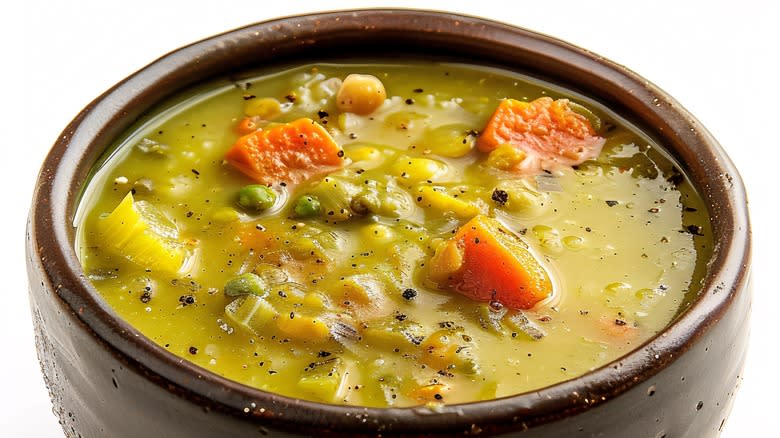The Ancient Origins Of Split Pea Soup

Soups are typically straightforward in their construction but possess a deeply nourishing quality. Just look at the best soup recipes; they reach for a simple pairing of ingredients that are delightfully aromatic in liquid form. It's a deeply human manner of cooking, with the earliest soup-like evidence tracing 20,000 B.C. to a cave in China. From there on out, soup never quite faded away and evolved into many renditions over the centuries. In fact, some of the most widespread soups trace back to ancient times.
One such example is the comfort classic: split pea soup. Made from a dried version of the legume, it's a tasty and functional dish with roots in ancient Greece. It's documented that vendors sold the soup streetside around the fourth or fifth century B.C. The dish caught on with the Romans, too -- going by the name pultes pisanae, it was often prepared for the military.
Various split pea soup recipes continued through the early centuries and into the Middle Ages. Dried peas proved to be an economical foodstuff, ready for storage over winter months. Finally, the addition of ham came in the 17th century by way of Britain. The cured meat was introduced to increase the nutritional content of the dish and remained a fundamental addition in most versions of the dish.
Read more: 25 Types Of Potatoes And When To Use Them
Split Pea Soup Has Remained Popular Since Ancient Greek Times

Peas are one of those wondrous ingredients that are so easily overlooked. They've been part of the human diet for millennia, with consumption starting in a debated part of Asia as early as 10,000 B.C. The legume made it to Europe via trade routes and stuck around, becoming incorporated in cuisines across the region. It's estimated that the practice of drying peas began around 2,000 B.C. in China and spread westward, too.
That's all to say that split peas have deep roots in Europe, so it's no surprise many soup renditions have evolved since ancient Greek and Roman times. In Scandinavia, the dish has been a wintertime favorite from the Medieval period, first appearing in Sweden and spreading to nearby neighbors. Here, the dried peas are frequently joined by mustard and onions for flavor. The dish also spread to Germany, where it's called Erbsensuppe, and is now known for a particularly smoky flavor. In France, the dish took on a particularly refined form called Potage Saint Germain. Made for Louis XIV, it features pork belly, and an aromatic blend of alliums.
Especially thanks to its durable nature, it's no surprise European settlers carried the soup to America. Ham continued as a fixture, likely due to its popularity in Britain. And now, the dish remains a favorite across the U.S. So next time you're firing up a batch of slow-cooker split pea soup, know that you're continuing a deeply rooted tradition that traces back thousands of years.
Read the original article on Tasting Table.

 Yahoo Lifestyle
Yahoo Lifestyle 
